

Compact Muon Solenoid
LHC, CERN
| CMS-PAS-B2G-18-001 | ||
| Search for a W' boson decaying to a vector-like quark and a top or bottom quark in the all-jets final state | ||
| CMS Collaboration | ||
| July 2018 | ||
| Abstract: A search for a heavy W' resonance decaying to one B or T vector-like quark and either a top or bottom quark, respectively, is presented using proton-proton collision data collected in 2016 by the CMS detector at the LHC. Both decay channels result in a top quark, Higgs boson, and a b quark, each produced with significant energy. The high energy of the final state jets can be investigated with boosted heavy resonance identification techniques, which help suppress standard model backgrounds. The W' decay channel to B and T is analyzed using the invariant mass of these boosted jets. The primary background in this final state is comprised uniquely of jets produced through the strong interaction, and is estimated from data using control regions based on inverting the boosted jet identification criteria. No significant deviations are observed, and cross section upper limits as a function of the W' invariant mass are presented using 35.9 fb$^{-1}$ of integrated luminosity. | ||
|
Links:
CDS record (PDF) ;
inSPIRE record ;
CADI line (restricted) ;
These preliminary results are superseded in this paper, JHEP 03 (2019) 127. The superseded preliminary plots can be found here. |
||
| Figures | |

png pdf |
Figure 1:
The W' boson decays considered in the analysis. The analysis assumes equal branching fraction for W' to tB and bT and 50% for each VLQ to qH. |

png pdf |
Figure 1-a:
The W' boson decays considered in the analysis. The analysis assumes equal branching fraction for W' to tB and bT and 50% for each VLQ to qH. |
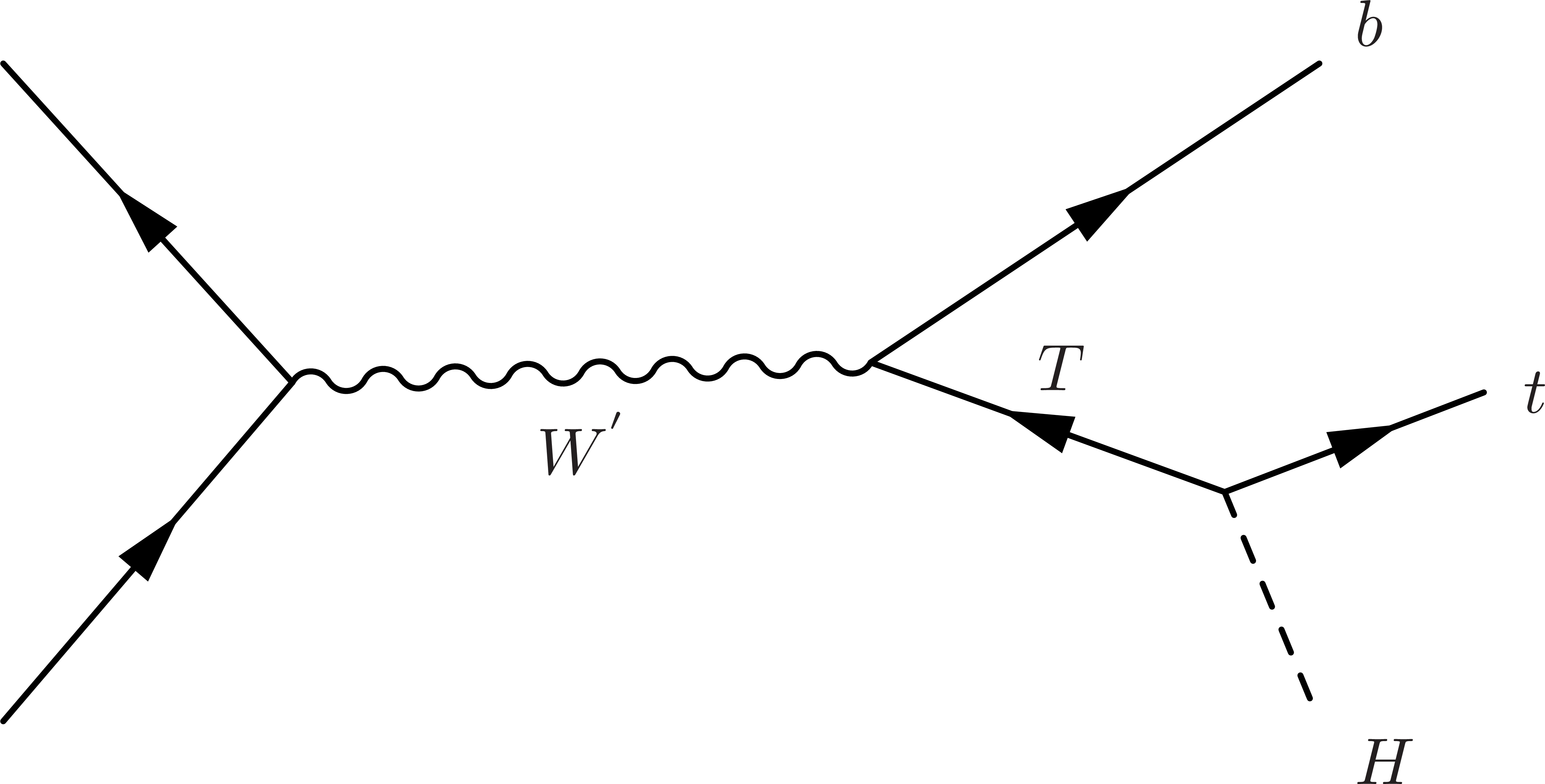
png pdf |
Figure 1-b:
The W' boson decays considered in the analysis. The analysis assumes equal branching fraction for W' to tB and bT and 50% for each VLQ to qH. |
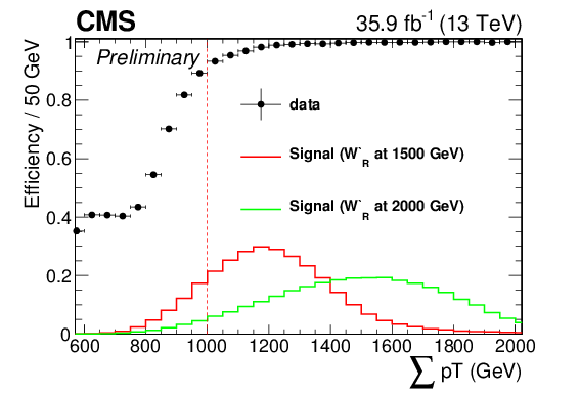
png pdf |
Figure 2:
Trigger efficiency as a function of summed AK4 jet $ {p_{\mathrm {T}}} $. The minimum in this analysis is 1.0 TeV as shown by the red dashed line. |
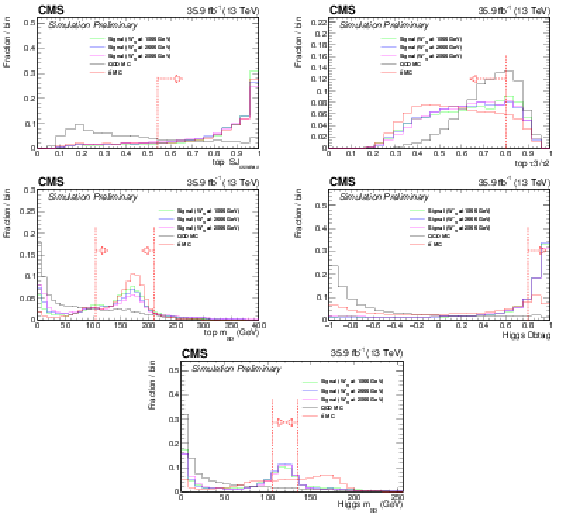
png pdf |
Figure 3:
Normalized distributions of discriminating variables in $ {{\mathrm {t}\overline {\mathrm {t}}}} $, QCD, and signal MC simulation. The QCD distributions are extracted from sets with minimum generator $ {H_{\mathrm {T}}} > $ 1000 GeV. From upper left to lower right, maximum subjet b tag for top quark discrimination, $\tau _{\mathrm {3}}$/ $\tau _{\mathrm {2}}$ for top quark discrimination, softdrop mass used for top quark discrimination, double b tag discriminant used for Higgs jet tagging, and softdrop mass used for Higgs jet tagging. Each variable distribution in this set of figures requires an event that passes the selection on all other variables in order to preserve possible correlations. |

png pdf |
Figure 3-a:
Normalized distributions of discriminating variables in $ {{\mathrm {t}\overline {\mathrm {t}}}} $, QCD, and signal MC simulation. The QCD distributions are extracted from sets with minimum generator $ {H_{\mathrm {T}}} > $ 1000 GeV. From upper left to lower right, maximum subjet b tag for top quark discrimination, $\tau _{\mathrm {3}}$/ $\tau _{\mathrm {2}}$ for top quark discrimination, softdrop mass used for top quark discrimination, double b tag discriminant used for Higgs jet tagging, and softdrop mass used for Higgs jet tagging. Each variable distribution in this set of figures requires an event that passes the selection on all other variables in order to preserve possible correlations. |

png pdf |
Figure 3-b:
Normalized distributions of discriminating variables in $ {{\mathrm {t}\overline {\mathrm {t}}}} $, QCD, and signal MC simulation. The QCD distributions are extracted from sets with minimum generator $ {H_{\mathrm {T}}} > $ 1000 GeV. From upper left to lower right, maximum subjet b tag for top quark discrimination, $\tau _{\mathrm {3}}$/ $\tau _{\mathrm {2}}$ for top quark discrimination, softdrop mass used for top quark discrimination, double b tag discriminant used for Higgs jet tagging, and softdrop mass used for Higgs jet tagging. Each variable distribution in this set of figures requires an event that passes the selection on all other variables in order to preserve possible correlations. |
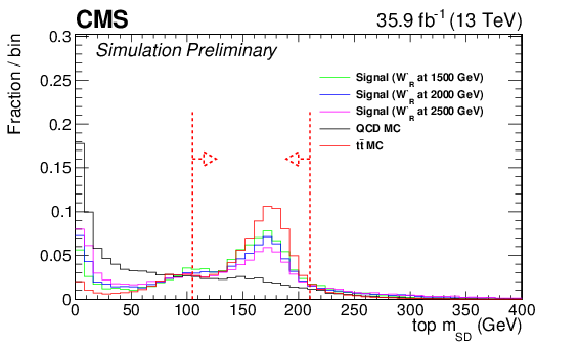
png pdf |
Figure 3-c:
Normalized distributions of discriminating variables in $ {{\mathrm {t}\overline {\mathrm {t}}}} $, QCD, and signal MC simulation. The QCD distributions are extracted from sets with minimum generator $ {H_{\mathrm {T}}} > $ 1000 GeV. From upper left to lower right, maximum subjet b tag for top quark discrimination, $\tau _{\mathrm {3}}$/ $\tau _{\mathrm {2}}$ for top quark discrimination, softdrop mass used for top quark discrimination, double b tag discriminant used for Higgs jet tagging, and softdrop mass used for Higgs jet tagging. Each variable distribution in this set of figures requires an event that passes the selection on all other variables in order to preserve possible correlations. |
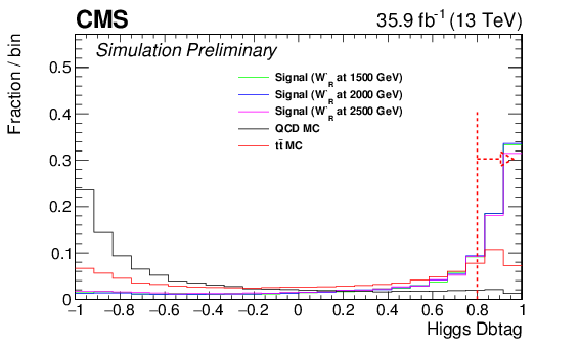
png pdf |
Figure 3-d:
Normalized distributions of discriminating variables in $ {{\mathrm {t}\overline {\mathrm {t}}}} $, QCD, and signal MC simulation. The QCD distributions are extracted from sets with minimum generator $ {H_{\mathrm {T}}} > $ 1000 GeV. From upper left to lower right, maximum subjet b tag for top quark discrimination, $\tau _{\mathrm {3}}$/ $\tau _{\mathrm {2}}$ for top quark discrimination, softdrop mass used for top quark discrimination, double b tag discriminant used for Higgs jet tagging, and softdrop mass used for Higgs jet tagging. Each variable distribution in this set of figures requires an event that passes the selection on all other variables in order to preserve possible correlations. |
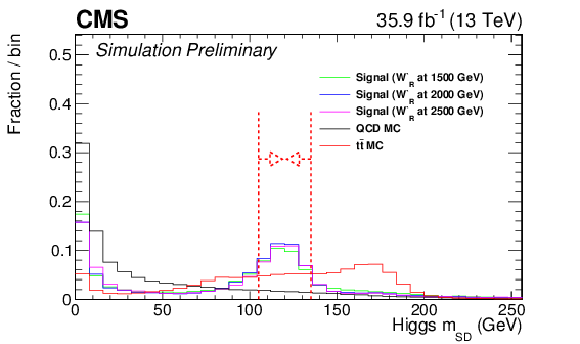
png pdf |
Figure 3-e:
Normalized distributions of discriminating variables in $ {{\mathrm {t}\overline {\mathrm {t}}}} $, QCD, and signal MC simulation. The QCD distributions are extracted from sets with minimum generator $ {H_{\mathrm {T}}} > $ 1000 GeV. From upper left to lower right, maximum subjet b tag for top quark discrimination, $\tau _{\mathrm {3}}$/ $\tau _{\mathrm {2}}$ for top quark discrimination, softdrop mass used for top quark discrimination, double b tag discriminant used for Higgs jet tagging, and softdrop mass used for Higgs jet tagging. Each variable distribution in this set of figures requires an event that passes the selection on all other variables in order to preserve possible correlations. |
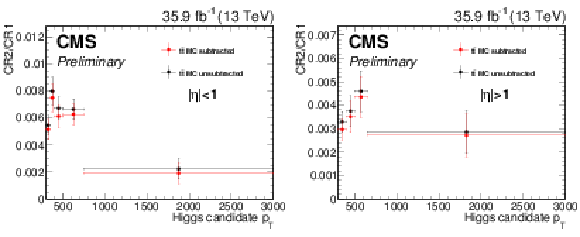
png pdf |
Figure 4:
Transfer function $ {\mathrm {F}({p_{\mathrm {T}}},\eta)} $ used for estimation of the QCD background estimate in the signal region. in the central (left) and high (right) $\eta $ regions. |
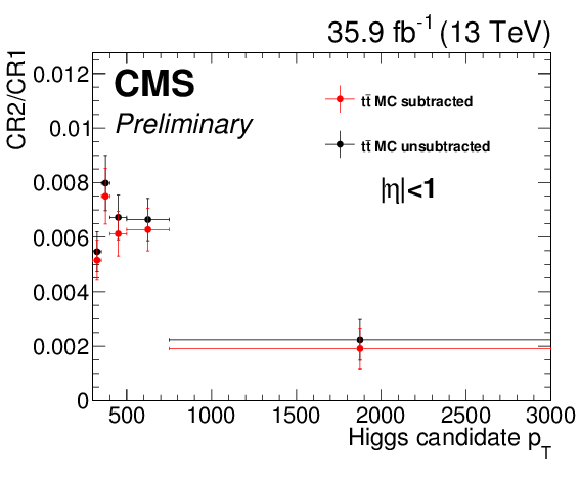
png pdf |
Figure 4-a:
Transfer function $ {\mathrm {F}({p_{\mathrm {T}}},\eta)} $ used for estimation of the QCD background estimate in the signal region. in the central (left) and high (right) $\eta $ regions. |
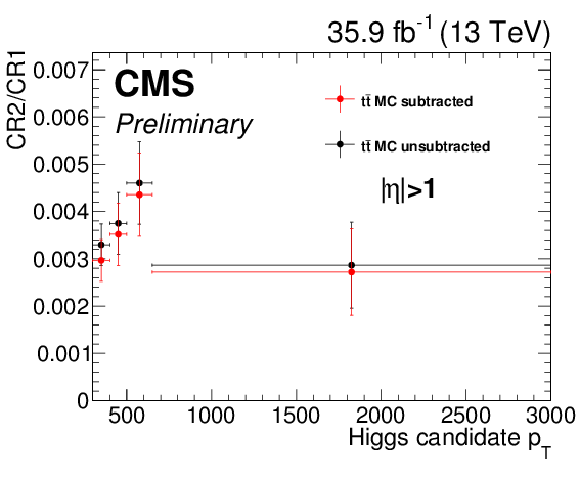
png pdf |
Figure 4-b:
Transfer function $ {\mathrm {F}({p_{\mathrm {T}}},\eta)} $ used for estimation of the QCD background estimate in the signal region. in the central (left) and high (right) $\eta $ regions. |
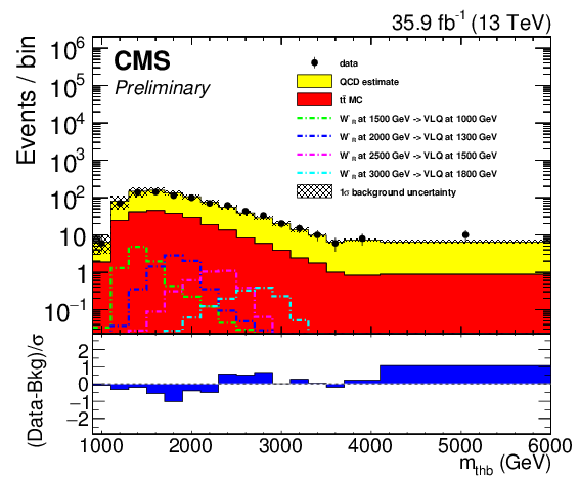
png pdf |
Figure 5:
Reconstructed W' mass distributions ($ {m_{\mathrm {thb}}} $) in the b candidate inverted validation region (CR4) shown for data and background contributions. Several signal hypotheses are shown to demonstrate the low signal contamination. The background uncertainty takes into account all systematic and statistical uncertainties considered. |
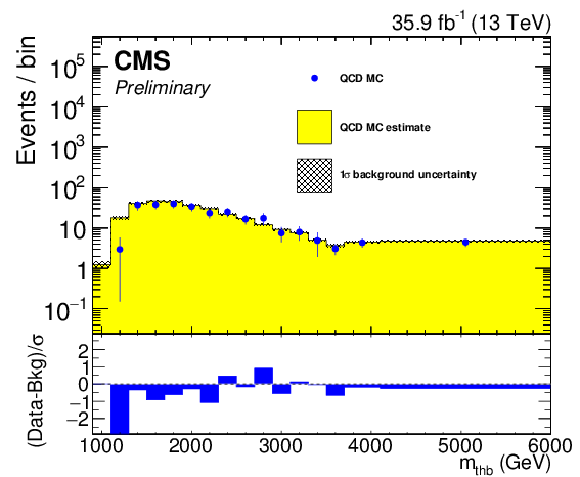
png pdf |
Figure 6:
Reconstructed W' mass distributions ($ {m_{\mathrm {thb}}} $) in the QCD MC in the signal region for the purposes of validation. The agreement given the systematic uncertainties is at the 1$\sigma $ level. The background uncertainty takes into account all systematic and statistical uncertainties used for limit setting. |
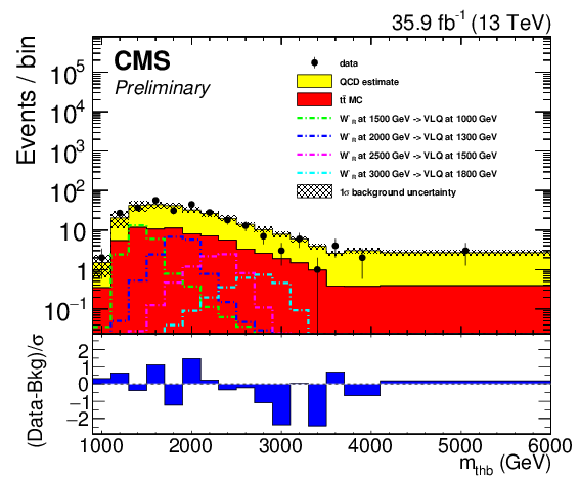
png pdf |
Figure 7:
Reconstructed W' mass distributions ($ {m_{\mathrm {thb}}} $) in the signal region with estimated backgrounds, and several signal W' boson models. Signal represents the summed contribution from the T and B branching fractions assuming equal probability. The uncertainties shown in the hatched region contain both statistical and systematic uncertainties of all background components. |
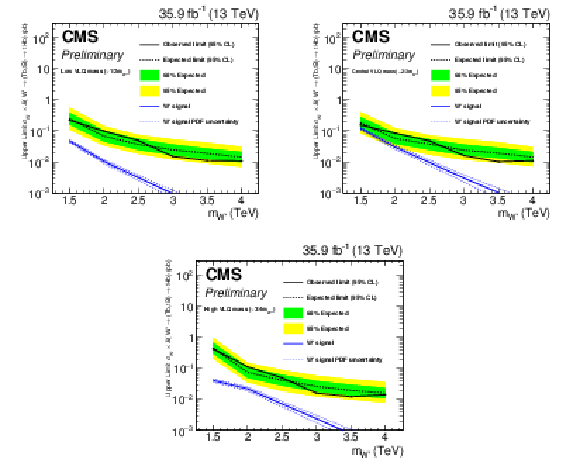
png pdf |
Figure 8:
The W' boson 95% CL production cross section limits. The expected (dashed) limits, observed (solid), as well as W' boson theoretical cross section, and the PDF and $Q^2$ normalization uncertainties are shown. The uncertainty in the expected limit band represents the 68% and 95% confidence intervals. The limits given low (top-left), central (top-right), and high (bottom) VLQ mass range (see Tab. 1) are shown. |
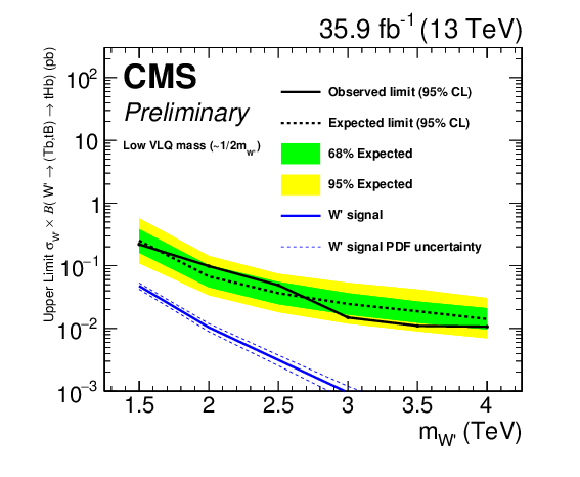
png pdf |
Figure 8-a:
The W' boson 95% CL production cross section limits. The expected (dashed) limits, observed (solid), as well as W' boson theoretical cross section, and the PDF and $Q^2$ normalization uncertainties are shown. The uncertainty in the expected limit band represents the 68% and 95% confidence intervals. The limits given low (top-left), central (top-right), and high (bottom) VLQ mass range (see Tab. 1) are shown. |

png pdf |
Figure 8-b:
The W' boson 95% CL production cross section limits. The expected (dashed) limits, observed (solid), as well as W' boson theoretical cross section, and the PDF and $Q^2$ normalization uncertainties are shown. The uncertainty in the expected limit band represents the 68% and 95% confidence intervals. The limits given low (top-left), central (top-right), and high (bottom) VLQ mass range (see Tab. 1) are shown. |
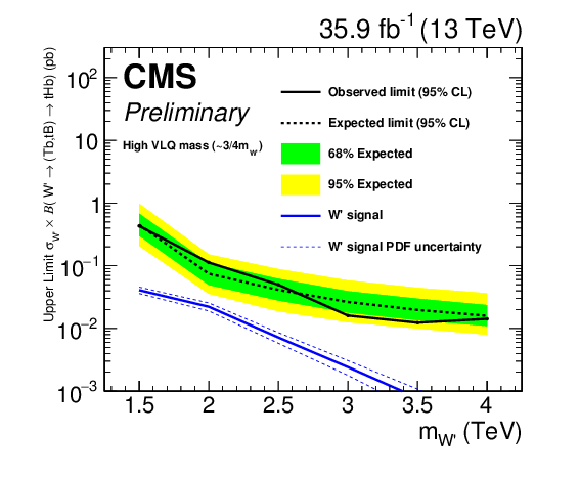
png pdf |
Figure 8-c:
The W' boson 95% CL production cross section limits. The expected (dashed) limits, observed (solid), as well as W' boson theoretical cross section, and the PDF and $Q^2$ normalization uncertainties are shown. The uncertainty in the expected limit band represents the 68% and 95% confidence intervals. The limits given low (top-left), central (top-right), and high (bottom) VLQ mass range (see Tab. 1) are shown. |
| Tables | |

png pdf |
Table 1:
The selection efficiency (%) for each signal point in the analysis. |

png pdf |
Table 2:
Selection regions used in the analysis. Cut discriminator selections and regions described in the text are explicitly defined here. |
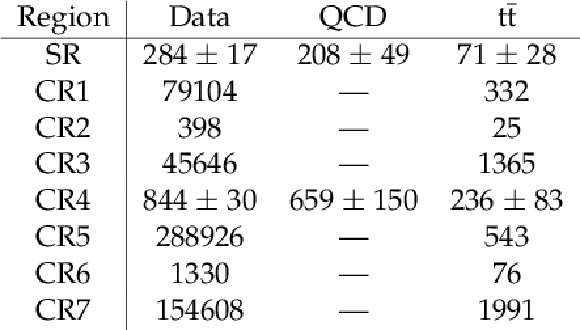
png pdf |
Table 3:
Event yield table after various selections. All MC yields are scaled to 35.9 fb$^{-1}$ and the theory cross section. Refer to Tab. 2 for the definition of each region. The uncertainties here are shown for the validation region and the signal region and are pre fit; the posteriori uncertainties for $ {{\mathrm {t}\overline {\mathrm {t}}}} $ and QCD are constrained down by approximately 40% and 14% respectively. |

png pdf |
Table 4:
Sources of systematic uncertainty affecting the $ {m_{\mathrm {thb}}} $ distribution. Sources that list the changes as $ \pm $1$ \sigma $ depend on the distribution of the variable given in the parentheses, while those that list the variation in percent are rate uncertainties. |
| Summary |
| A search for a heavy W' resonance decaying to one B or T vector-like quark and either a top or bottom quark respectively has been presented. The data correspond to 35.9 fb$^{-1}$ of integrated luminosity and was collected in 2016 by the CMS detector at the LHC. The final state considered for both signatures was a top quark, Higgs boson, and b quark. Boosted heavy resonance identification techniques which result in the event signature of three highly energetic jets were used in order to suppress standard model backgrounds. No significant deviations were observed, and cross section upper limits as a function of the W' invariant mass were presented. |
| References | ||||
| 1 | M. Schmaltz and D. Tucker-Smith | Little Higgs theories | Ann. Rev. of Nucl. and Part. Sci. 55 (2005) 229 | hep-ph/0502182 |
| 2 | T. Appelquist, H.-C. Cheng, and B. A. Dobrescu | Bounds on universal extra dimensions | PRD 64 (2001) 035002 | hep-ph/0012100 |
| 3 | R. N. Mohapatra and J. C. Pati | Left-right gauge symmetry and an 'isoconjugate' model of CP violation | PRD 11 (1975) 566 | |
| 4 | CMS Collaboration | Search for heavy gauge W' boson in events with an energetic lepton and large missing transverse momentum at $ \sqrt{s} = $ 13 TeV | PLB 770 (2017) | CMS-EXO-15-006 1612.09274 |
| 5 | ATLAS Collaboration | Search for a new heavy gauge boson resonance decaying into a lepton and missing transverse momentum in 36 fb$ ^{-1} $ of $ pp $ collisions at $ \sqrt{s} = $ 13 TeV with the ATLAS experiment | 1706.04786 | |
| 6 | CMS Collaboration | Search for a heavy resonance decaying to a pair of vector bosons in the lepton plus merged jet final state at $ \sqrt{s} = $ 13 TeV | CMS-B2G-16-029 1802.09407 |
|
| 7 | M. Aaboud et al. | Search for WW/WZ resonance production in $ \nu $qq final states in pp collisions at sqrt(s)=13 TeV with the ATLAS detector | JHEP (2018) 42 | |
| 8 | A. M. Sirunyan et al. | Searches for W' bosons decaying to a top quark and a bottom quark in proton-proton collisions at 13 TeV | JHEP (2017) 29 | |
| 9 | ATLAS Collaboration | Search for W' $ \rightarrow $ tb decays in the hadronic final state using $ pp $ collisions at $ \sqrt{s}= $ 13 TeV with the ATLAS detector | PLB 781 (2018) | |
| 10 | K. Agashe, R. Contino, and A. Pomarol | The minimal composite Higgs model | NPB 719 (2005) 165 | |
| 11 | CMS Collaboration | CMS luminosity measurements for the 2016 data taking period | CMS-PAS-LUM-17-001 | CMS-PAS-LUM-17-001 |
| 12 | N. Vignaroli | New W′ signals at the LHC | PRD 89 (2014) 095027 | 1404.5558 |
| 13 | CMS Collaboration | Particle-flow reconstruction and global event description with the CMS detector | JINST 12 (2017) P10003 | CMS-PRF-14-001 1706.04965 |
| 14 | D. Bertolini, P. Harris, M. Low, and N. Tran | Pileup per particle identification | JHEP (2014) 59 | |
| 15 | CMS Collaboration | The CMS experiment at the CERN LHC | JINST 3 (2008) S08004 | CMS-00-001 |
| 16 | S. Frixione, P. Nason, and C. Oleari | Matching NLO QCD computations with parton shower simulations: the POWHEG method | JHEP 0711 (2007) 070 | 0709.2092 |
| 17 | S. Alioli, P. Nason, C. Oleari, and E. Re | A general framework for implementing NLO calculations in shower Monte Carlo programs: the POWHEG BOX | JHEP 06 (2010) 043 | 1002.2581 |
| 18 | P. Nason | A new method for combining NLO QCD with shower Monte Carlo algorithms | JHEP 11 (2004) 040 | hep-ph/0409146 |
| 19 | S. Frixione, P. Nason, and G. Ridolfi | A Positive-weight next-to-leading-order Monte Carlo for heavy flavour hadroproduction | JHEP 09 (2007) 126 | 0707.3088 |
| 20 | J. Alwall et al. | The automated computation of tree-level and next-to-leading order differential cross sections, and their matching to parton shower simulations | JHEP 07 (2014) 079 | 1405.0301 |
| 21 | J. Alwall et al. | Comparative study of various algorithms for the merging of parton showers and matrix elements in hadronic collisions | EPJC53 (2008) 473 | 0706.2569 |
| 22 | T. Sjostrand et al. | An introduction to PYTHIA 8.2 | CPC 191 (2015) 159 | 1410.3012 |
| 23 | CMS Collaboration | Investigations of the impact of the parton shower tuning in Pythia 8 in the modelling of $ \mathrm{t\overline{t}} $ at $ \sqrt{s}= $ 8 and 13 TeV | CMS-PAS-TOP-16-021 | CMS-PAS-TOP-16-021 |
| 24 | CMS Collaboration | Event generator tunes obtained from underlying event and multiparton scattering measurements | EPJC 76 (2016) 155 | CMS-GEN-14-001 1512.00815 |
| 25 | GEANT4 Collaboration | Geant 4 - a simulation toolkit | NIM506 (2003) 250 | |
| 26 | M. Cacciari, G. P. Salam, and G. Soyez | The anti-$ k_t $ jet clustering algorithm | JHEP 04 (2008) 063 | 0802.1189 |
| 27 | M. Cacciari, G. P. Salam, and G. Soyez | Fastjet user manual | EPJC 72 (2012) 1896 | 1111.6097 |
| 28 | CMS Collaboration | Jet algorithms performance in 13 TeV data | CMS-PAS-JME-16-003 | CMS-PAS-JME-16-003 |
| 29 | J. Thaler and K. Van Tilburg | Maximizing boosted top identification by minimizing N-subjettiness | JHEP 02 (2012) 093 | 1108.2701 |
| 30 | M. Dasgupta, A. Fregoso, S. Marzani, and G. P. Salam | Towards an understanding of jet substructure | JHEP 29 | |
| 31 | A. J. Larkoski, S. Marzani, G. Soyez, and J. Thaler | Soft Drop | JHEP 05 (2014) | 1402.2657 |
| 32 | CMS Collaboration | Identification of heavy-flavour jets with the CMS detector in pp collisions at 13 TeV | JINST (2017) | CMS-BTV-16-002 1712.07158 |
| 33 | CMS Collaboration | Search for massive resonances decaying into $ WW $, $ WZ $, $ ZZ $, $ qW $, and $ qZ $ with dijet final states at $ \sqrt{s}=13\text{}\text{}\mathrm{TeV} $ | PRD 97 072006 | |
| 34 | ATLAS Collaboration | Measurement of the inelastic proton-proton cross section at $ \sqrt{s} = $ 13 TeV with the ATLAS detector at the LHC | PRL 117 (2016) 182002 | 1606.02625 |
| 35 | CMS Collaboration | Measurement of differential cross sections for top quark pair production using the $ \text{lepton}+\text{jets} $ final state in proton-proton collisions at 13 TeV | PRD 95 (2017) 092001 | |
| 36 | NNPDF Collaboration | Parton distributions from high-precision collider data | EPJC 77 (2017) 663 | 1706.00428 |
| 37 | R. Barlow and C. Beeston | Fitting using finite Monte Carlo samples | CPC 77 (1993) 219 | |

|
Compact Muon Solenoid LHC, CERN |

|

|

|

|

|

|